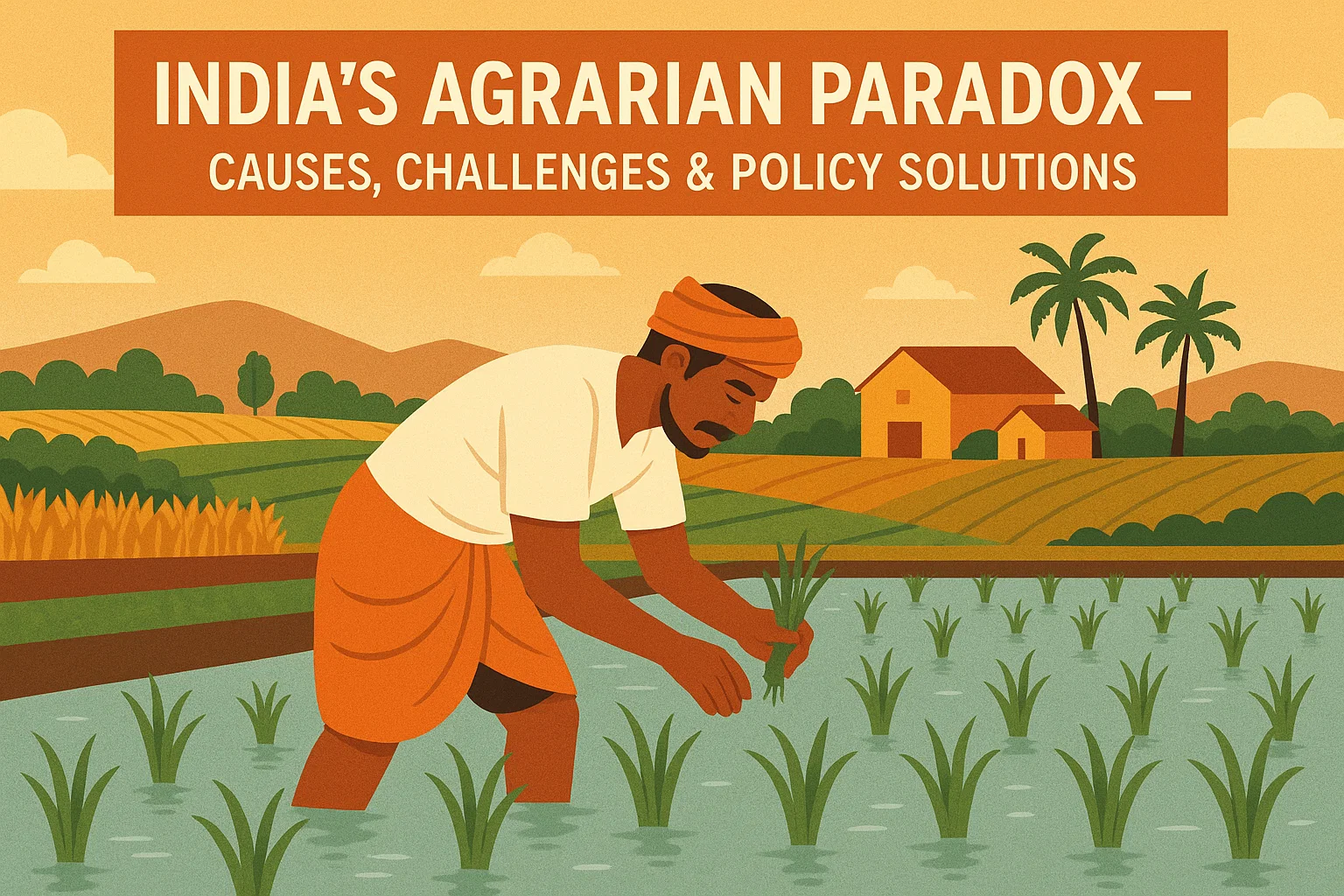India’s Agrarian Paradox – Causes, Challenges & Policy Solutions
Explore India’s agrarian paradox—how record agricultural production coexists with rising imports and a shrinking trade surplus. Understand key challenges such as fragmented landholdings, low productivity, water stress, climate impacts, policy distortions, and the way forward for a competitive, resilient farm economy.
India’s Agrarian Paradox
Recent data from the Directorate General of Commercial Intelligence and Statistics reveals a concerning trend in India’s agricultural trade.
Why is the agrarian sector in India essential?
- The agrarian sector is the bedrock of the Indian economy and a critical pillar of its socio-economic fabric. It ensures food security for a population of over 1.4 billion people.
- It is the largest employer, providing livelihood to nearly half of the workforce.
- Furthermore, a robust agricultural sector is a vital contributor to the national economy and serves as a key stabiliser for India’s balance of payments by generating a consistent trade surplus, which helps offset deficits in other sectors like energy.
What is the paradox witnessed in the agrarian sector?
- The central paradox is the coexistence of record-high domestic production and rapidly rising imports in key commodity segments.
- Despite record production of foodgrains and horticulture, the sector’s net surplus is shrinking. While exports have stagnated, imports of agricultural and allied products have surged from $33.79 billion in 2022-23 to $36.96 billion in 2024-25.
- India celebrates bumper harvests of staples like wheat and rice, yet it faces a diminishing agricultural trade surplus because it is importing high-value goods like edible oils, fruits, nuts, and cocoa preparations.
- The nation has the natural resources and farmer capability to produce these items, but the economic and policy framework makes it easier and often more economical to import them than to build competitive domestic supply chains.
What are the other major challenges of the agrarian sector in India?
Beyond the trade paradox, the sector faces multifaceted challenges:
- Fragmented Land Holdings: Small and dispersed landholdings hinder economies of scale and mechanisation. As per the Economic Survey 2021-22, around 85% of the landholdings are less than 2 hectares which has been increasing as land is siphoned off as collaterals to manage rising agrarian debts (noted by the RBI Working Group on Agricultural Credit).
- Indebtedness and Agrarian Distress: High input costs and volatile market prices often trap farmers in a cycle of debt.
- Low Productivity: Yields for many crops remain below global averages due to outdated practices. This has been majorly due to lack of farm mechanisation, which in turn, has been low due to fragmented land holdings.
- Post-Harvest Losses: Inadequate cold storage, warehousing, and transport infrastructure lead to significant waste. As per the NABARD Consultancy Services (NABCONS), more than 20% of the agrarian production gets affected due to lack of storage (for rice and wheat, this loss goes up to around 35%).
- Water Stress: Over-exploitation of groundwater and inefficient irrigation practices pose a severe sustainability threat.
- Climate Change: Increasing frequency of droughts, floods, and unseasonal weather events disrupts agricultural cycles. The Economic Survey 2024-25 identified heatwave as a major cause of concern for food inflation in India due to lowered agrarian production.
What are the major causes behind such issues?
The root causes are deeply embedded in policy design and market structures:
- Subsidy-Driven Cropping Pattern: Policies like the Minimum Support Price (MSP) and subsidised fertilizers disproportionately incentivise the production of water-intensive staples (wheat and rice) over high-value, nutrient-rich crops.
- This creates a “cropping trap” where farmer choices are driven by subsidy assurance rather than market demand.
- Import as a Safety Valve: The government frequently uses tariff cuts and import relaxations to control domestic food inflation. While effective in the short term, this disincentivises long-term private investment in building resilient domestic supply chains for diversified products.
- Policy Focus on Stability over Competitiveness: Agricultural policy has historically prioritised price stabilisation and protecting political constituencies over fostering long-term competitiveness, quality upgradation, and export orientation.
- Weak Market Linkages: Farmers often lack direct access to processors and retailers, who then turn to imports for consistent quality and timely supply.
What measures have been taken to address the issues?
The government has initiated several schemes to tackle these structural problems:
- PM-AASHA (Pradhan Mantri Annadata Aay Sanrakshan Abhiyan): Aims to ensure better price realisation for farmers through mechanisms like Price Deficiency Payment.
- National Mission on Edible Oils – Oil Palm (NMEO-OP): Aims to boost domestic production of oilseeds and reduce the massive import bill for edible oils.
- Agriculture Infrastructure Fund (AIF): Provides financial support for building post-harvest management infrastructure like cold storages and warehouses.
- Formation of FPOs (Farmer Producer Organisations): Aims to aggregate farmers to achieve economies of scale and improve market access.
- Promotion of Horticulture Clusters: Focused interventions to enhance productivity and value addition in high-value horticulture.
What are the other ways forward?
To reverse the current trend, a multi-pronged strategy is needed:
- Reorient Subsidies: Shift incentives from input subsidies to direct income support and investments that promote diversification, soil health, and water conservation.
- Build Quality Infrastructure: Massive public and private investment in cold chains, logistics, and quality testing labs is crucial to reduce waste and meet global standards.
- Predictable Trade Policy: Move away from ad-hoc import bans and tariff cuts to a stable and predictable tariff regime that provides certainty for domestic investors.
- Focus on Value Addition: Encourage food processing industries through the Production Linked Incentive (PLI) scheme to create demand for diversified farm produce.
- Strengthen R&D: Invest in research for high-yield, climate-resilient varieties of pulses, oilseeds, and millets.
Subscribe to our Youtube Channel for more Valuable Content – TheStudyias
Download the App to Subscribe to our Courses – Thestudyias
The Source’s Authority and Ownership of the Article is Claimed By THE STUDY IAS BY MANIKANT SINGH



